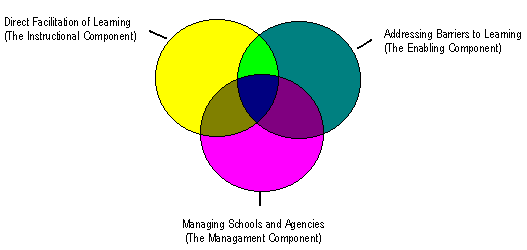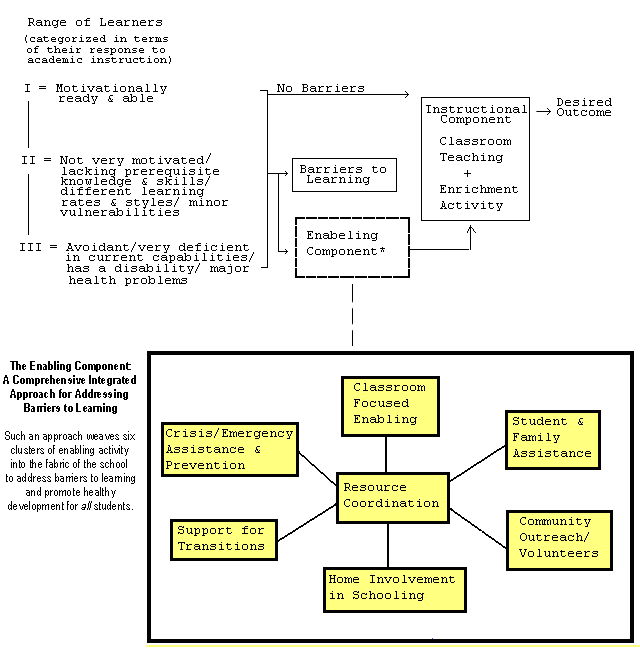Introduction
Even more fundamentally than establishing linkages between community agencies
and school sites, school and community policy must start to reflect the reality that there
are three primary and essential components to be addressed in systemic reform and
restructuring of schools and community agencies.
As illustrated below, these are the instructional, enabling, and management
components.
Three Components to be Addressed in Systemic Reform
 Central to an effective enabling
component is activity to address health and psychosocial problems.
Central to an effective enabling
component is activity to address health and psychosocial problems.
School-owned enabling activity -- such as pupil services and the multi-components of a
school health program -- must be coordinated and integrated not only with each other but
with community-owned resources.
And the overlapping enabling, instructional, and management components must be carried
out as a cohesive whole if we are to effectively address the many barriers interfering
with the appropriate and effective functioning of students.
Emergence of a cohesive Enabling Component requires (1) weaving together what is
available at a school, (2) expanding what exists by integrating school and community
resources, and (3) enhancing access to community programs and services by linking as many
as feasible to programs at school sites in ways that can serve a complex of schools.
Based on analyses of what schools and communities already are doing, enabling activity
can be clustered into six program areas. These encompass interventions to
- work with teachers to enhance classroom based efforts to enable learning
- provide prescribed student and family assistance
- respond to and prevent crises
- support student and family transitions
- mobilize parent/home involvement in schooling and health promotion
- outreach to develop greater community involvement and support (including recruitment of
volunteers).
A brief sketch of each of these programmatic areas follows.
Return to
Classroom Focused Enabling
When a teacher encounters difficulty in working with a youngster, the first step is to
see whether there are ways to address the problem within the regular classroom and perhaps
with added home involvement. Thus the emphasis here is on enhancing classroom-based
efforts to enable learning by increasing teacher effectiveness for preventing and handling
problems in the classroom. This is accomplished by providing personalized help to increase
a teacher's array of strategies for working with a wider range of individual differences.
For example, teachers learn to use peer tutoring and volunteers to enhance social and
academic support and to increase their range of accommodative strategies and their ability
to teach students compensatory strategies; and as appropriate, they are provided support
in the classroom from resource and itinerant teachers and counselors. Two aims of all this
are to increase mainstreaming efficacy and reduce the need for special services.
Work in this area requires
programs for personalized professional development (for teachers and aides)
systems to expand resources
programs for temporary out of class help
programs to develop aides, volunteers, and any others who help in classrooms or who work
with teachers to enable learning.
Through classroom-focused enabling programs, teachers are better prepared to address
similar problems when they arise in the future.
(The classroom curriculum, of course, already should encompass a focus on fostering
socio-emotional and physical development. Such a focus is seen as an essential element in
preventing learning, behavior, emotional, and health problems.)
Return to
Student and Family Assistance
Some problems cannot be handled without special interventions, thus the need for student and
family assistance. The emphasis here is on providing special services in a personalized
way to assist with a broad-range of needs. To begin with, available social, physical and
mental health programs in the school and community are used. As community outreach brings
in other resources, they are linked to existing activity in an integrated manner. Special
attention is paid to enhancing systems for triage, case and resource management, direct
services to meet immediate needs, and referral for special services and special education
resources and placements as appropriate. Ongoing efforts are made to expand and enhance
resources. As major outcomes, the intent is to ensure special assistance is provided when
necessary and appropriate and that such assistance is effective.
Work in this area requires
programs designed to support classroom focused enabling -- with specific emphasis on
reducing the need for teachers to seek special programs and services
a stakeholder information program to clarify available assistance and how to access help
systems to facilitate requests for assistance and strategies to evaluate the requests
(including use of strategies designed to reduce the need for special intervention)
a programmatic approach for handling referrals
programs providing direct service
programmatic approaches for effective case and resource management
interface with community outreach to assimilate additional resources into current service
delivery.
Return to
The intent here is to respond to, minimize the impact of, and prevent crises. Desired
outcomes of crisis assistance include ensuring immediate emergency and follow-up care is
provided so students are able to resume learning without undue delay. Prevention activity
outcomes are reflected in measures showing there is a safe and productive environment and
that students and their families have the type of attitudes and capacities needed to deal
with violence and other threats to safety.
![]() identify three components that need to be
addressed in school and community efforts for systemic reform
identify three components that need to be
addressed in school and community efforts for systemic reform![]() identify six program areas of an enabling
component
identify six program areas of an enabling
component
